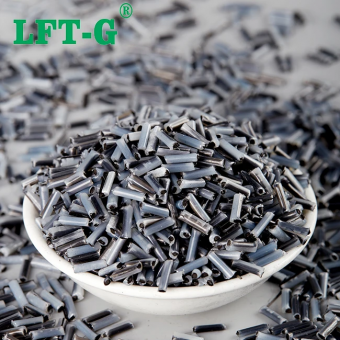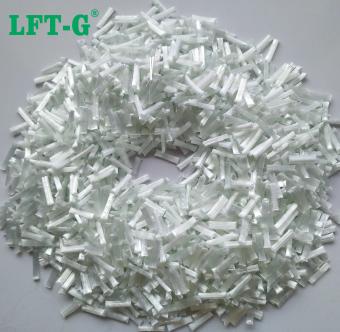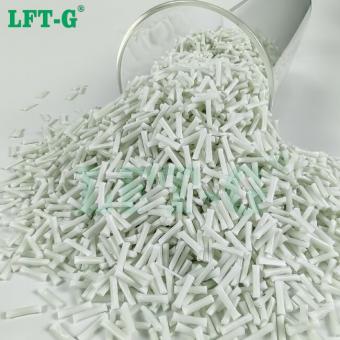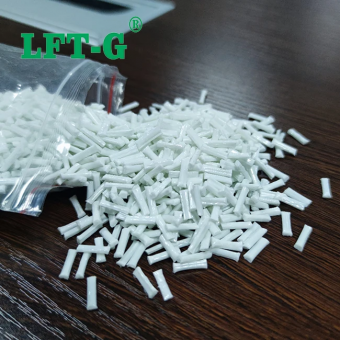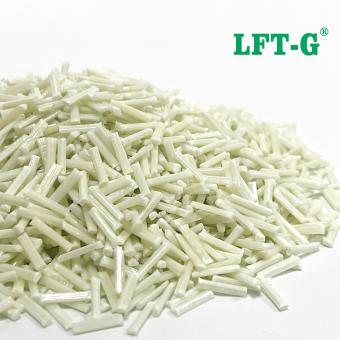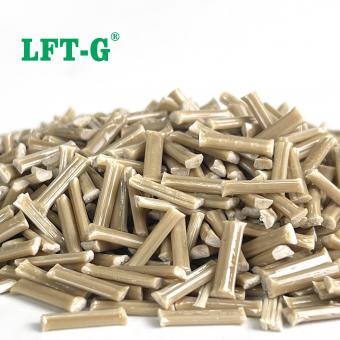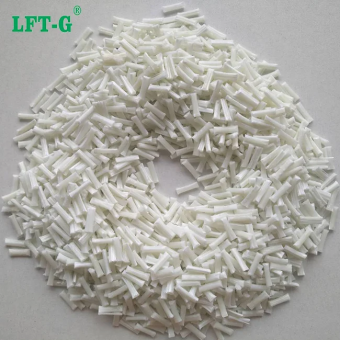-
Xiamen LFT-G TPU filling Long glass fiber reinforced compounds for engineering useWhat is the TPU material? TPU is thermoplastic polyurethane, which is a kind of polyurethane that can be plasticized by heating and dissolved by solvent. Compared with the mixed and cast polyurethane, the chemical structure of thermoplastic polyurethane has no or little chemical crosslinking, its molecules are basically linear, but there is a certain amount of physical exchange. The concept of physical exchange, as it is called, was developed in 1958 by SchollenbergeC. First of all, it is proposed that there is a "connection point" between linear polyurethane molecular chains that is reversible in the presence of heat or solvent, which is not actually chemical crosslinking, but plays the role of chemical crosslinking. Due to this physical crosslinking, polyurethane has formed the theory of polyphase morphology structure. The hydrogen bond of polyurethane strengthens its morphology and makes it withstand higher humidity. According to soft segment structure can be divided into polyester type, polyether type and butadiene type, they contain ester group, ether group or butadiene group respectively. According to the hard segment structure, they can be divided into aminoester type and aminoester urea type, which are obtained from diol chain extender or diamine chain extender, respectively. The common division is polyester type and polyether type. Why filling Long Glass Fiber? Long glass fiber reinforced composites can solve your problems when other methods of reinforced plastics do not provide the performance you need or if you want to replace the metal with plastic. Long glass fiber reinforced composites can cost-effectively reduce the cost of goods and effectively improve the mechanical properties of engineering polymers, and increase the durability by forming long fibers to form a long-fiber-reinforced internal skeleton network. Performance is preserved in a wide range of environments. TDS of TPU-LGF Application Details Xiamen lft composite plastic Co., Ltd Xiamen LFT Composite Plastic Co.,LTD was established in 2009, is a brand-name global suppliers of long fiber reinforced thermoplastic materials integrating product research & development(R&D), production and sale marketing. Our LFT products have passed the ISO9001&16949 system certification and have obtained lots of national trademarks and patents, covering the fields of automotive, military parts and firearms, aerospace, new energy, medical equipment, power wind energy, sports equipment, etc.
- Thermoplastic Polyurethane lgf
- lft-g tpu resin glass fiber shoes toes
- tpu reinforced lgf instead of metal
- tpu composite material manufacturer price
- long glass fiber tpu China supplier
- tpu modified material lgf industrials use
Tags :
-
Xiamen LFT-G Polyamide 66 long glass fiber reinforced thermoplastic compounds high strengthWhat is PA66? PA66, abbreviation of Polyamide 66, chemical name polyadiptyl adiptyl diamine, commonly known as nylon 66. Is a colorless transparent semi-crystalline thermoplastic polymer, widely used in automobiles, electronic appliances, mechanical instruments, industrial parts and other industries. What is PA66-LGF? However, due to the large absorbency of nylon itself, poor acid resistance, low impact strength of dry state and low temperature, and easy deformation after water absorption, the dimensional stability of the product is affected, so that its application range is limited to some extent. In order to improve the above shortcomings, expand its application field, and better meet the requirements of performance, people adopt a variety of methods to modify PA66 plastic, so as to improve the impact property, thermal deformation property, forming processing property and chemical corrosion resistance. Because the specific strength and Young's modulus of glass fiber (LGF) are 10~20 times larger than that of PA66, the linear expansion coefficient is about 1/20 of that of PA66, the water absorption is close to zero, and it has good heat and chemical resistance, glass fiber filling is the most commonly used enhancement modification method of PA66. PA66 is the variety with the highest mechanical strength and the most widely used in PA series. Because of its high crystallinity, it has high rigidity and heat resistance. TDS of Polyamide 66 filling LGF Translucent or opaque opalescent crystalline polymer with plasticity. It has excellent wear resistance, self lubricity and high mechanical strength. Application 1. The automobile industry Because of its excellent heat resistance, chemical resistance, strength and convenient processing, nylon 66 has been widely used in the automobile industry. At present, it can be used in almost all parts of the automobile, such as the engine parts, electrical parts and body parts. The engine part includes the intake system and the fuel system, such as the engine cylinder head cover, throttle, air filter machine housing, vehicle air horn, vehicle air conditioning hose, cooling fan and its housing, water inlet pipe, brake oil tank and cover, and so on. Body parts include: car fender, rear view mirror frame, bumper, dashboard, luggage rack, door handle, wiper bracket, seat belt buckle, interior decoration and so on. Car electric appliances such as electric control doors and Windows, connectors, crisper, cable tie wire. 2. Electronic and Electrical industries PA66 can produce electronic and electrical insulation parts, precision electronic instrument parts, electrical lighting appliances and electronic and electrical parts, can be used to make rice cookers, electric vacuum cleaners, high-frequency electronic food heaters, etc. PA66 has excellent solder resistance and is widely used in the production of junction boxes, switches and resistors. Flame retardant grade PA66 can be used for color TV wire clip, fixing clip and focusing knob. 3. Machinery transportation and machinery and equipment industry PA66 can be used for door handles of passenger cars and brake joint discs of freight cars. Other products such as insulation washer, baffle seat, turbine, propeller shaft, screw propeller and sliding bearing on ship can also be made with PA66. High impact resistance nylon 66 can also be made pipe pliers, plastic molds, radio control body, etc. Unreinforced grade nylon 66 is usually used to manufacture nuts, bolts, screws, nozzles, etc. with low creep and no corrosion. Reinforced grade nylon 66 used in the production of chains, conveyor belts, fan blades, impeller and scaffolding fixed foot buckle. Details Number Color Length MOQ Package Sample Delivery time Port of Loading PA66-NA-LGF30 Original color or Customized 6-25mm 25kg 25kg/bag Available 7-15 days after shipment Xiamen Port Frequently asked questions 1. How to choose the fiber content of the product? Is the larger product suitable for higher fiber content material? A. This is not absolute. The content of glass fiber is not more is better. The suitable content is just to meet the requirements of each products. 2. Can products with appearance requirements be made of long-fiber materials? A. The main feature of LFT-G thermoplastic long glass fiber and long carbon fiber is to show the mechanical properties. If the customer has bright or other requirements for the appearance of the product, it needs to be evaluated in combination with specific products. 3. How to choose the reinforcement method and length of the material when using long fiber reinforced thermoplastic material? A. The selection of materials depend on the requirements of the products. It is necessary to assess how much the content is enhanced and how much length is more appropriate, which are depending on the performance requirements of the products.
- Polyamide 66 lgf filling lgf high rigidity
- long glass fiber polyamide66 instead metal steel
- pa66 lgf30 car parts and other products
- long fibre reinforced thermoplastics nylon 66
- long fiber compounds pa66 cut down cost
- polyamide 6.6 lgf30 GF
Tags :
-
Xiamen LFT-G Polybutylene terephthalate contain long glass fiber reinforced PBT compoundsProduct grade: General grade Fiber specification: 20%-60% Product feature: High toughness, Low warpage Product application: Electronic appliances, Machinery parts etc.
- PBT resin great mechanical strength
- Electronic appliances use PBT-GF instead metal
- sample available PBT self factory made good price
- Natural color PBT filling LGF 20%-60%
- Fiber filling material injection molded PBT
- High toughness and strength PBT fiberglass
Tags :
-
Xiamen LFT-G High toughness MXD6 composite filling long glass fiber original colorMXD6 Nylon - MXD6 is a kind of crystalline polyamide resin, which is synthesized by the condensation of m-benzoylamine and adipic acid. The advantages of nylon MXD6 1. in a wide range of temperature, maintain high strength, high rigidity 2. High thermal deformation temperature and small thermal expansion coefficient 3. Low water absorption rate, small size change after water absorption, less mechanical strength reduction 4. forming shrinkage rate is very small, suitable for precision forming processing 5. excellent coating, especially suitable for high temperature surface coating 6. oxygen, carbon dioxide and other gases also have excellent barrier Application of MXD6 in plastic modification industry MXD6 can be combined with fiberglass, carbon fiber, mineral, and/or advanced fillers for use in fiberglass reinforced materials containing 50-60% and for exceptional strength and stiffness. Even when filled with high glass content, its smooth, resin-rich surface produces a fibre-free high gloss surface, ideal for painting, metal-plating, or creating naturally reflective shells. 1. suitable for high liquidity of thin wall It is a very fluid resin that can easily fill thin walls as thin as 0.5 mm thick even when the glass fiber content is as high as 60%. 2. Excellent surface finish A resin-rich perfect surface has a highly polished appearance, even with a high glass fiber content. 3. High strength and stiffness The tensile and flexural strength of MXD6 is similar to that of many cast metals and alloys with the addition of 50-60% glass fiber reinforced material. 4. good dimensional stability At ambient temperatures, the linear expansion coefficient (CLTE) of MXD6 glass fiber composites is similar to that of many cast metals and alloys. Strong reproducibility due to low shrinkage and the ability to maintain tight tolerances (length tolerances as low as ± 0.05% if properly formed). Datasheet Tested by our own lab, for reference only. laboratory & Warehouse Frequently asked questions 1. How to choose the fiber content of the product? Is the larger product suitable for higher fiber content material? A. This is not absolute. The content of glass fiber is not more is better. The suitable content is just to meet the requirements of each products. 2. Can products with appearance requirements be made of long-fiber materials? A. The main feature of LFT-G thermoplastic long glass fiber and long carbon fiber is to show the mechanical properties. If the customer has bright or other requirements for the appearance of the products, it needs to be evaluated in combination with specific products. 3. Are there any special process requirements of long carbon fiber injection molding products? A. We must consider the requirements of long fiber for the injection molding machine screw nozzle, mold structure and injection molding process. Long fiber is a relatively high cost materiaql, and need to evaluate the cost performance problem in the selection process. Main materials Why choose us 1. Integration of R&D, production and sales 2. Customized products, one-to-one pre-sales and after-sales service 3. Passed a number of system certifications, and product quality is stable 4. Five warehousing centers nationwide to meet customers' high-volume needs 5. Testing is available in an independent laboratory with technical experts with 30 years of experience 6. Sold globally to Asia, Europe, North America, Middle East
- Crystalline nylon resin mxd6 gf good price
- Composite materials with long glass fiber mxd6
- Higher performance plastic mxd6
- Made in China products compounds mxd6
- Customized plastic fiber glass add high sstrength mxd6
- Thermoplastic resin thermoplastic resin
Tags :
-
Xiamen LFT-G High strength Polyamide 12 composite lgf virgin white color for automotiveProduct number: PA12-NA-LGF Fiber specification: 20%-60% Product feature: High strength, High toughness and durability Product application: Suitable for automotive, sports parts, solar energy, photovoltaic industry and other industries.
- Nylon12 nylon high performance
- Durability pa
- Photovoltaic industry
- Injection grade pa12
- 24h service composite
- Supplier price
Tags :
-
LFT-G PLA Polylactic acid composite long glass fiber thermoplastic original colorPLA PLA (polylactic acid) is also known as polylactic acid, the production process of polylactic acid is pollution-free, and the product can be biodegradable to achieve recycling in nature, so it is an ideal green polymer material, and one of the representatives of biodegradable plastics. The structure of PLA has important influence on its heat resistance, toughness, mechanical strength, degradability and biocompatibility. The influence on heat resistance is mainly discussed below. There is only one submethylene on the main chain of PLA molecule, the molecular chain has a spiral structure, and its activity is poor. As a result, the PLA after injection molding almost does not crystallize due to slow crystallization speed, so the heat resistance of the product is poor. During hot processing, the ester bond is partially broken to produce terminal carboxyl group, which plays an autocatalytic degradation effect on the thermal degradation of PLA. LGF reinforced PLA The rigidity of the fiber makes it play the role of skeleton support in the polymer matrix. When the polymer is heated, the movement of the chain segment is limited, thus improving the heat resistance of the material. At present, the fibers that can be used for enhancement modification of PLA include natural plant fiber (sisal, flax, linen, bamboo, coconut, wood fiber, etc.), natural animal fiber (silk, etc.), mineral fiber (basalt fiber, etc.), and chemical fiber (carbon fiber, glass fiber, etc.). Among these fibers, carbon fiber and glass fiber are widely used for their high strength and high modulus. Natural plant fiber has been widely studied because of its wide source, degradability and improved thermal and mechanical properties of composites. Modified natural fiber and modified inorganic fiber (glass fiber or carbon fiber) were mixed into the PLA matrix to prepare two kinds of fiber reinforced PLA composites. The test results show that the Vica softening temperature of the composites exceeds 140℃. Compared with Short fiber(SGF) Compared with the short fiber, it has more excellent performance in mechanical properties. It is more suitable for large products and structural parts. It has 1-3 times higher (toughness) than short fiber, and the tensile strength (strength and rigidity) is increased by 0.5-1 times. Injection molding Lab Warehouse Certification Xiamen LFT composite plastic Co., Ltd Xiamen LFT composite plastic Co., Ltd. is a brand-name company that focuses on LFT&LFRT. Long Glass Fiber Series (LGF) & Long Carbon Fiber Series (LCF). The company's thermoplastic LFT can be used for LFT-G injection molding and extrusion, and can also be used for LFT-D molding. It can be produced according to customer requirements: 5~25mm in length. The company's long-fiber continuous infiltration reinforced thermoplastics have passed ISO9001&16949 system certification, and the products have obtained lots of national trademarks and patents.
- PLA composite plastic
- polyactic acid materials
- modified pla compounds
- pla long glass fiber lgf
- long glass fiber filling pla
- lft-g pla lgf
Tags :
-
LFT polyphenylene sulfide Long Fiber Thermoplastic PPS LGF40% CompositeProduct Name: Long glass fiber 40% Fill PPS Length:About 12mm Applicaiton:Auto parts, energy components and other plastic partsview more
-
Xiamen LFT Polyetheretherketone CF composite 20%-60% high performance natural colorProduct grade: General grade Fiber specification: 20%-60% Product feature: Flame resistant, Heat resistant, Chemical resistant, Low friction coefficient, Good load bearing Product application: Aviation, Machinery, Electronics, Chemicals, Automotive, Other high-tech fields.
- Good load bearing polyetheretherketone
- Low friction coefficient made bu own factory
- Own factory made pure and virgin peek
- Wide useage peek industrial materials reinforced peek
- Customized materials peek toughness Carbon
- Long Glass Fiber can be recycled peek aerospace
Tags :
-
Xiamen LFT-G Polyphenyl sulfide filled 30% LCF PPS flame retardant grade UL-94 V0Polyphenylene sulfide is a new functional engineering plastic.
- Polyphenyl sulfide long carbon fibre
- PPS plastic rein forced compounds
- Composite material pps industrial use
- Filling lcf 30 pps composite plastic new materials
- High flame retardant car parts
- Factory use raw material modified plastic high performance
Tags :
-
Xiamen LFT-G Polyamide 66 composite material filling long carbon fiber reinforced pellets for aerospaceProduct number: PA66-NA-LCF50 Fiber specification: 20%-60% Product feature: High toughness, Light weight, High strength, Wear reisistance, Corrosion resistance, Creep resistance, Conduction, Heat transfer Product application: The wing of the aircraft, Duck wing, Stable wing, Nacelle and other aerospace fileds.
- Light weight pa66 compounds instead metal
- aerospace fileds high tech materials
- conduction nylon 6.6 carbon fibre
- Sample available can be customized pa66 lft
- Black color composite modified pa66 for car parts
- Thermoplastic material LFT-G injection molding pa6/6
Tags :
-
Xiamen LFT-G PLA Polylactic acid filling Long carbon fiber modified compunds high performancePLA information PLA, also known as polylactide, refers to the polyester polymer obtained by polymerization of lactic acid as the main raw material, usually using renewable plant resources (such as corn, cassava, etc.) made of starch as raw material. It is a new type of renewable biodegradable material. PLA material characteristics The raw materials are renewable and relatively easy to obtain even if used as 3D printing materials, which can be used for large-scale production; The PLA has good thermal stability and solvent resistance. The processing temperature of PLA is between 170 ℃ and 230℃, and the finished product has good heat resistance. Good permeability and transparency luster, can be processed by extrusion, spinning, biaxial stretching, injection blow molding and other ways, tensile and bending modulus can be comparable to the traditional plastic resin; High biocompatibility. The monomer material of PLA, L-lactic acid, is an endogenous active substance in human body. Therefore, the finished product printed by 3D printing material PLA is non-toxic to human body and can be absorbed by human body. It has good degradability. Different from the degradation methods of other 3D printing materials, PLA is embedded in the soil and completely degraded by microorganisms in nature under specific conditions to generate carbon dioxide and water. The carbon dioxide generated directly enters the soil organic matter or is absorbed by plants instead of being discharged into the air, which is recognized as an environmentally friendly material. Application of PLA materials Due to the good mechanical and physical properties of PLA material, PLA material is widely used, including various food containers, packaged food, fast food lunch boxes, etc. At the same time, with its advantages in compatibility and degradability, PLA can also play a large role in the medical field, which can be made into medical tissue skeleton material and medical carrier for human body. In addition to its excellent tensile strength and extensibility, PLA can be produced by various common processing methods, such as melt extrusion molding, injection molding, blow film molding, foam molding and vacuum molding. About us
- polylactide can be recycled plastic
- biodegradable materials made in China
- new renewable plastic pla
- PLA-LCF composite made in China
- low warpage plastic pla green materials
- industrial use pla injection molding
Tags :

 e-mail
e-mail English
English français
français Deutsch
Deutsch русский
русский italiano
italiano español
español português
português العربية
العربية 日本語
日本語 한국의
한국의 中文
中文





